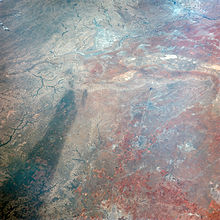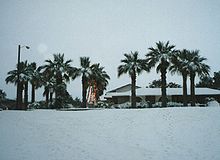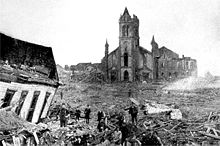- Climate of Texas
-
 This image of Texas, obtained by astronauts aboard NASA's Gemini 4 spacecraft shows a large dark swath attributed to rainfall.
This image of Texas, obtained by astronauts aboard NASA's Gemini 4 spacecraft shows a large dark swath attributed to rainfall.
Texas's climate varies widely, from arid in the west to humid in the east. Due to its large size, Texas is home to several different climates. There are several distinct regions within the state which have varying climates: Northern Plains, Trans-Pecos Region, Texas Hill Country, Piney Woods, and South Texas. Generally speaking, the eastern half of Texas is humid subtropical, while the western half is semi-arid (with some arid regions). While snowfall is more common across northern Texas than southern sections, large snowfall totals have occurred near and along the middle and upper Texas coasts.
Texas ranks first in tornado occurrence with an average of 139 per year. Tropical cyclones can impact the state from the Gulf of Mexico, or from an overland trajectory originating in the eastern Pacific ocean. Those originating from the Gulf of Mexico are more likely to strike the upper Texas coast than elsewhere. Significant floods have occurred across the state throughout history, both from tropical cyclones and from stalled weather fronts.
Contents
Characteristics by region
Northern Plains
Monthly normal high and low temperatures (°F) for various Northern Plains cities City Jan Feb Mar Apr May Jun Jul Aug Sep Oct Nov Dec Abilene 55/32 61/37 69/44 77/52 85/61 91/69 95/72 94/71 87/64 78/54 65/42 57/34 Amarillo 49/23 54/27 62/34 71/42 79/52 87/61 91/65 89/64 82/56 72/45 58/32 50/24 Lubbock 52/24 58/29 66/36 75/45 83/56 90/64 92/68 90/66 83/58 74/47 62/35 53/26 Midland 60/29 66/34 74/41 82/48 89/58 94/65 96/68 94/67 88/61 80/51 68/39 61/31 San Angelo 58/29 63/34 71/42 79/50 86/59 91/66 95/70 94/68 88/63 79/51 67/39 59/31 Wichita Falls 52/29 58/34 67/41 76/49 84/59 92/68 97/72 96/71 88/64 77/52 64/40 54/31 [1] The Northern Plains' climate is semi-arid and is prone to drought, annually receiving between 16 and 32 inches (810 mm) of precipitation. During the summer, this area of state sees the most clear days.[1] Winter nights commonly see temperatures fall below the freezing mark, or 32 °F (0 °C). The wettest months of the year are April and May.[2] Tornadoes, caused by the convergence of westerly and southerly prevailing winds during the late spring, are common, making the region part of Tornado Alley.[3] Poor land management, drought, and high wind speeds can cause large dust storms, minimized in modern times by improved land-management practices, but most troublesome in the 1930s during the Dust Bowl period.[4] The panhandle region, farthest from the Gulf of Mexico, experiences colder winters than the other regions of Texas.[5]
Trans Pecos Region
Monthly normal high and low temperatures (°F) for various Trans Pecos cities City Jan Feb Mar Apr May Jun Jul Aug Sep Oct Nov Dec El Paso 57/33 63/38 70/44 78/51 87/61 95/69 94/72 92/70 87/64 78/52 66/40 57/33 [2] The Trans-Pecos region, also known as Far West Texas and the Big Bend Country, is the farthest west region in geography, consisting of the Chihuahuan Desert and isolated mountain ranges. During fall, winter, and spring, it experiences the most clear days statewide.[1] It is also the driest receiving an average annual rainfall of only 16 inches (410 mm) or less. The arid climate is the main reason for desertification of the land, but overgrazing is slowly widening the land area of that desert. In the mountain areas one can see coniferous forests in a wetter and more temperate environment. The wettest months in this region occur during the summer.[2] Winds are strengthened as they are forced to push through canyons and valleys. In the flatter areas these winds are harvested into usable electricity.
Hill Country
Monthly normal high and low temperatures (°F) for Hill Country cities City Jan Feb Mar Apr May Jun Jul Aug Sep Oct Nov Dec Austin 60/40 65/44 73/51 79/58 85/65 91/71 95/73 96/73 90/69 81/60 70/49 62/42 San Antonio 62/39 67/43 74/50 80/57 86/66 91/72 95/74 95/74 90/69 82/59 71/49 64/41 Waco 57/33 62/38 70/46 78/53 84/63 91/70 96/74 96/73 90/66 79/57 68/45 59/36 [3] The Texas Hill Country, or central Texas is shaped by its many rivers and hills. The climate is on the western edge of humid subtropical, with cool winters and hot summers. The vegetation is both deciduous in the river valleys, and coniferous where there is greater elevation. In a single year the region can receive up to 48 inches (1,200 mm) of rain, and flooding is common near rivers and in low lying areas. The wettest months of the year are April and May.[2]
Piney Woods
Monthly normal high and low temperatures (°F) for various Piney Woods locations City Jan Feb Mar Apr May Jun Jul Aug Sep Oct Nov Dec Dallas 55/36 61/41 69/49 77/56 84/65 92/73 96/77 96/76 89/69 79/58 66/47 57/39 Fort Worth 55/31 61/36 68/44 76/52 83/61 91/69 97/72 96/72 89/65 79/55 67/44 58/35 Galveston 62/50 64/52 70/58 75/65 81/72 87/78 89/80 89/79 87/76 80/68 71/59 64/52 Houston 63/45 67/48 74/55 79/61 86/68 91/74 94/75 93/75 89/72 82/62 73/53 65/47 Port Arthur 61/43 65/46 72/52 78/59 84/66 89/72 92/74 92/73 88/69 80/60 71/51 64/45 [4] The Piney Woods is the eastern region of Texas and is within the humid subtropical climate zone. It receives the most rainfall; more than 87 inches (2,200 mm) annually in the far east. This is due to the gulf currents that carry humid air to the region, where it condenses and precipitates out in the vicinity of sea breeze fronts as well as when extratropical cyclones move by. While coastal sections see the most cloudy days statewide and year-round, northern sections see the most clear days during the summer.[1] The wettest months of the year are April and May.[2] The area is prone to severe thunderstorms and tornadoes when the proper conditions exist, generally in the springtime. Hurricanes also strike the region, the most disastrous of which was the Galveston Hurricane of 1900.[6] More recently Hurricane Rita pummeled the Golden Triangle of southeast Texas.[7] The higher humidity of the region amplifies the feeling of heat during the summer. During winter and spring along the immediate coast, temperatures are kept cool by relatively cool gulf waters. Dense advection fog can form when warm air moves over the cool shelf waters during February and March, stopping ship traffic for days.
South
Monthly normal high and low temperatures (°F) for southern Texas cities City Jan Feb Mar Apr May Jun Jul Aug Sep Oct Nov Dec Brownsville 69/50 72/53 78/59 82/65 87/72 91/75 92/75 93/75 89/73 84/66 77/59 70/52 Corpus Christi 66/46 70/49 76/56 81/62 86/69 90/74 93/74 93/75 90/72 84/64 75/55 68/48 Del Rio 63/40 68/44 76/52 83/59 89/67 94/72 96/74 96/74 91/69 82/61 71/49 63/41 Laredo 68/44 73/48 82/56 89/63 95/70 100/74 102/75 99/75 93/71 86/63 76/53 68/45 Victoria 63/44 67/47 73/54 79/60 85/68 90/73 93/75 94/75 90/70 83/62 73/52 65/45 [5] The region of South Texas includes the semiarid ranch country and the wetter Rio Grande Valley. Considered to be the southernmost tip of the American Great Plains region, the inland region has rainfall that is similar to that of the Northern Plains. The coastal areas are nearly warm most of the year due to currents of the Gulf of Mexico, but can get cold in winter if a strong front comes in, and sometimes even causing snow at sea level. Summers are hot and humid. Rain in the coastal region is more abundant than in the inland region, and subtropical forests line the Rio Grande River. The wettest months of the year are April and May.[2] Inland, where it is drier, ranches dominate the landscape, characterized by thick spiny brush and grasslands. The winters in the inland region are cold and dry as Arctic air makes it into the region, therefore making snow a rare occurrence due to the lack of humidity in winter, and the summers are for the most part hot and dry, but at times can be humid if winds come off the warmer Gulf of Mexico. Tornadoes can occur in this region, but less frequent than in other parts of the state.
Cold and snow
 2004 Christmas Eve Snowstorm in South Texas
2004 Christmas Eve Snowstorm in South Texas
Northern and western sections of the state average snowfall annually due to their colder average readings each winter. For one week in February 1956, a snow storm of historic proportions struck northern Texas. The maximum amount measured was 61 inches (150 cm) at Vega, Texas with Plainview, Texas receiving 24 inches (61 cm) in one day.[8] El Paso, in Far West Texas, received 22.4 in (57 cm) of snow during a 24-hour period 13-14 December 1987.[9] For central and southern sections, snowfall is considerably more unusual, but not unprecedented. In February 1895, a large area of southeastern Texas received over 12 inches (30 cm) of snow, with peak amounts near 30 inches (76 cm) at Port Arthur, Texas.[10] More recently around Christmas of 2004, up to 13 inches (33 cm) of snow fell along the middle coast, with the maximum occurring at Victoria, Texas.[11]
The worst cold snap to occur statewide occurred during the last half of December in 1983. Four stations recorded their longest continuous readings at or below 32 °F (0 °C) on record. At Austin, Texas, the temperature remained at or below freezing for 139 hours. At Abilene, Texas, the period at or below freezing totaled 202 hours. Lubbock, Texas saw temperatures at or below freezing for 207 hours. The Dallas-Fort Worth airport measured temperatures at or below freezing for a total of 296 consecutive hours. Snow which fell on December 14 and December 15 across northern Texas stayed on the ground until New Year's Day of 1984.[12]
Severe weather
Thunderstorms are very common in Texas, especially the eastern and northern portion of the state. Texas is part of the Tornado Alley section of the country. The state experiences the most tornadoes in the Union, an average of 139 a year. These strike most frequently in North Texas and the Panhandle.[3] Tornadoes in Texas generally occur in the months of April, May, and June.[13]
Hurricanes
Further information: List of Texas hurricanes (1980–present) Damage from the 1900 Galveston hurricane, the deadliest natural disaster in U.S. history, was extensive.
Damage from the 1900 Galveston hurricane, the deadliest natural disaster in U.S. history, was extensive.
Texas's position at the northwestern end of the Gulf of Mexico makes it vulnerable to hurricanes. Some of the most destructive hurricanes in U.S. history have impacted Texas. A hurricane in 1875 killed approximately 400 people in Indianola, followed by another hurricane in 1886 that destroyed the town, which was at the time the most important port city in the state. This allowed Galveston to take over as the chief port city, but it was subsequently devastated by a hurricane in 1900 that killed approximately 8,000 people (possibly as many as 12,000), making it the deadliest natural disaster in U.S. history. Other devastating Texas hurricanes include the 1915 Galveston Hurricane, Hurricane Carla in 1961, Hurricane Beulah in 1967, Hurricane Alicia in 1983, Hurricane Rita in 2005, and Hurricane Ike in 2008.[14]
The climatology of where tropical cyclone strikes are most likely within the state appears to be changing. In the early 1980s, the most favored region for strikes during the previous century was the middle coast.[2] However, that region of the coastline has been rarely impacted since the 1960s, and a recent study indicates that the most vulnerable location to a tropical cyclone strike since 1851 is the upper coast, which has received 56 percent of all tropical cyclone landfalls, of which 66 percent originate from the Gulf of Mexico. This is in contrast with Louisiana and the lower Texas coast, where only 39 percent of the landfalls are from tropical cyclones of Gulf of Mexico origin.[15]
Flooding
The most serious threat from tropical cyclones in Texas residents is from flooding. The worst aspect about tropical cyclones is that the weaker they are, the more efficient they can be at producing heavy rains and catastrophic flooding. Systems with sprawling circulations, such as Hurricane Beulah, also tend to make good rainmakers.[16] Slow moving systems, such as Tropical Storm Amelia (1978) also can produce significant rainfall over the Lone Star State.[17] Tropical cyclones from both the eastern Pacific and Atlantic Basins can impact the Lone Star State.[18] In general, flooding across Texas is more common during the spring and early autumn months, and it can also be due to nearby stationary fronts interacting with strong upper level cyclones.[19] The most likely location for floods statewide is the Balcones Escarpment, an area of steep elevation gradient in central Texas at the boundary between the Edwards Plateau and the coastal plain.[20]
Climate change
Main article: Climate change in TexasTexas emits the most greenhouse gases in the US.[21][22] The state's annual carbon dioxide emissions are nearly 1.5 trillion pounds (680 billion kg). Texas would be the world's seventh-largest producer of greenhouse gases if it were an independent nation.[22][23][24] The primary factors in Texas' greenhouse gas emissions are the state's large number of coal power plants and the state's refining and manufacturing industries which provides the bulk of the United States' petroleum products.[22]
Notes
- ^ a b c Texas Renewable Energy Resource Assessment. "Chapter 2: Texas Climate". pp. 2–9. http://docs.google.com/viewer?a=v&q=cache:EwC892MrgVgJ:www.seco.cpa.state.tx.us/publications/renewenergy/pdf/c02-texasclimate.pdf+1961-1990+averages+abilene,+texas&hl=en&gl=us&pid=bl&srcid=ADGEESjUPzZgyGHrSQr3-OKCxCE_k7z0gde5CELBQElE0dGvdubY9wnPRz94NkjDqsmw9bOxiDUHbRg_CJtYfGMJr9aatBJhg8HVmzgjZLjcmu4Kx8nTcl0lB2OT4c2b0jGX2vSdaEsN&sig=AHIEtbQ4N-4LKGZ4xf4OSfvqpQTGurlhVQ.
- ^ a b c d e f George W. Bomar (1983). Texas Weather. pp. 54–58. ISBN 0-292-78053-2.
- ^ a b National Climatic Data Center (2005). "Average Number of Tornadoes, 1953-2004". National Oceanic and Atmospheric Administration. http://www.ncdc.noaa.gov/img/climate/research/tornado/small/avgt5304.gif. Retrieved 2006-10-24.
- ^ "The American Experience: Surviving The Dust Bowl: People & Events: The Drought". PBS. http://www.pbs.org/wgbh/amex/dustbowl/peopleevents/pandeAMEX06.html. Retrieved 2008-12-29.
- ^ Texas Renewable Energy Resource Assessment. "Chapter 2: Texas Climate". pp. 2–6. http://docs.google.com/viewer?a=v&q=cache:EwC892MrgVgJ:www.seco.cpa.state.tx.us/publications/renewenergy/pdf/c02-texasclimate.pdf+1961-1990+averages+abilene,+texas&hl=en&gl=us&pid=bl&srcid=ADGEESjUPzZgyGHrSQr3-OKCxCE_k7z0gde5CELBQElE0dGvdubY9wnPRz94NkjDqsmw9bOxiDUHbRg_CJtYfGMJr9aatBJhg8HVmzgjZLjcmu4Kx8nTcl0lB2OT4c2b0jGX2vSdaEsN&sig=AHIEtbQ4N-4LKGZ4xf4OSfvqpQTGurlhVQ.
- ^ Eric S. Blake, Edward N. Rappaport, Christopher W. Landsea (2007). "The Deadliest, Costliest, and Most Intense United States Tropical Cyclones From 1851 to 2006". National Hurricane Center. http://www.nhc.noaa.gov/pdf/NWS-TPC-5.pdf. Retrieved 2007-06-23.
- ^ Richard D. Knabb, Daniel P. Brown, Jamie R. Rhome. "Hurricane Rita" (PDF). National Hurricane Center. http://www.nhc.noaa.gov/pdf/TCR-AL182005_Rita.pdf. Retrieved 2007-06-26.
- ^ George W. Bomar (1983). Texas Weather. p. 164. ISBN 0-292-78053-2.
- ^ National Weather Service Forecast Office, El Paso, Texas. "All time heavy snowfall events for El Paso". National Weather Service. http://www.srh.noaa.gov/epz/?n=elpaso_heavy_snow.
- ^ National Weather Service Forecast Office, Lake Charles, Louisiana (2010). "Snow Climatology for Southeast Texas & Southwest Louisiana: All Measurable Snowfalls (1895-2010)". National Weather Service Southern Region Headquarters.
- ^ National Weather Service Forecast Office, Houston/Galveston, Texas (2004-12-25). "Public Information Statement". National Weather Service Southern Region Headquarters. Archived from the original on 2006-12-12. http://web.archive.org/web/20061212134359/http://www.srh.noaa.gov/hgx/projects/xmasevesnow04/pns_snowfalltotal.txt. Retrieved 2006-12-01.
- ^ George W. Bomar (1983). Texas Weather. p. 158. ISBN 0-292-78053-2.
- ^ Weather from the Handbook of Texas Online Accessed 2008-07-22
- ^ Eric S. Blake, Edward N. Rappaport, Christopher W. Landsea (2007-04-15). "The Deadliest, Costliest, and Most Intense United States Tropical Cyclones From 1851 to 2006" (PDF). National Weather Service: National Hurricane Center. http://www.nhc.noaa.gov/pdf/NWS-TPC-5.pdf. Retrieved 2008-10-02.
- ^ Tanveerul Islam, Ph.D.; William Merrell, Ph.D.; William Seitz, Ph.D.; and Robert Harriss, Ph.D. (November 2009). "Origin, Distribution, and Timing of Texas Hurricanes: 1851–2006". Natural Hazards Review 10: 137–138. doi:10.1061/(ASCE)1527-6988(2009)10:4(136).
- ^ David M. Roth (2010-01-17). "Texas Hurricane History". Hydrometeorological Prediction Center. p. 5. http://www.hpc.ncep.noaa.gov/research/txhur.pdf. Retrieved 2010-04-09.
- ^ David M. Roth (2007-06-20). "Tropical Storm Amelia (1978) Rainfall Page". Hydrometeorological Prediction Center. http://www.hpc.ncep.noaa.gov/tropical/rain/amelia1978.html. Retrieved 2008-03-05.
- ^ David M. Roth (2010). "Tropical cyclones affecting the Gulf Coast". Hydrometeorological Prediction Center. http://www.hpc.ncep.noaa.gov/tropical/rain/tcgulfcoast.html. Retrieved 2008-03-07.
- ^ Earth Observatory (2004-04-09). "Intense Rains Flood Mexico and Texas". National Aeronautics and Space Administration. http://earthobservatory.nasa.gov/IOTD/view.php?id=4379. Retrieved 2010-04-09.
- ^ George W. Bomar (1983). Texas Weather. p. 63. ISBN 0-292-78053-2.
- ^ Borenstein, Seth (04-06-2007). "Blame Coal: Texas Leads in Overall Emissions". USA Today. http://www.usatoday.com/tech/news/2007-06-04-state-emissions_N.htm. Retrieved 2007-06-06.
- ^ a b c Associated Press (2007-06-03). "Texas No. 1 producer of greenhouse gases". Dallas Morning News. http://www.dallasnews.com/sharedcontent/dws/news/texassouthwest/stories/060307dnnatemissions.3c1df3a.html. Retrieved 2008-06-11.
- ^ MSN City Guides. "Five Cities that Need help Getting Green". http://cityguides.msn.com/citylife/greenslideshow.aspx?cp-documentid=4848635&imageindex=4.
- ^ Heinrich Boll Foundation North America (December 2003). "Approaches, Challenges, Potentials: Renewable Energy and Climate Change Policies in U.S. States". Clean Energy States Alliance. http://www.cleanenergyfunds.org/international/downloads/RE_Publication_Online.pdf. Retrieved 2010-04-09.
Climate of the United States States - Alabama
- Alaska
- Arizona
- Arkansas
- California
- Colorado
- Connecticut
- Delaware
- Florida
- Georgia
- Hawaii
- Idaho
- Illinois
- Indiana
- Iowa
- Kansas
- Kentucky
- Louisiana
- Maine
- Maryland
- Massachusetts
- Michigan
- Minnesota
- Mississippi
- Missouri
- Montana
- Nebraska
- Nevada
- New Hampshire
- New Jersey
- New Mexico
- New York
- North Carolina
- North Dakota
- Ohio
- Oklahoma
- Oregon
- Pennsylvania
- Rhode Island
- South Carolina
- South Dakota
- Tennessee
- Texas
- Utah
- Vermont
- Virginia
- Washington
- West Virginia
- Wisconsin
- Wyoming
Federal district Insular areas - American Samoa
- Guam
- Northern Mariana Islands
- Puerto Rico
- U.S. Virgin Islands
Categories:
Wikimedia Foundation. 2010.


